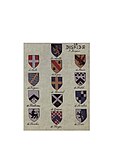Challenge of Barletta
This article needs additional citations for verification. (February 2013) |

The Challenge of Barletta (Italian: Disfida di Barletta) was a duel fought in the countryside of Trani, near Barletta, Southern Italy, on 13 February 1503, during the Third Italian War, on the plains between Corato and Andria.
Overview
[edit]The tournament was provoked by a French knight Charles de la Motte who, after drinking too much of the local wine, made disparaging remarks about the Italians.[1] It consisted in[clarification needed] a mounted tourney between 13 Italians (the most famous being Ettore Fieramosca), who were part of the Spanish army based in Barletta, and 13 French knights who were based in Canosa di Puglia. The Italian knights won the battle, and the French had to pay ransom. Barletta has since acquired the appellation Città della Disfida (City of the Challenge) as a result.
The event inspired a historical novel by the Italian writer Massimo D'Azeglio, Ettore Fieramosca, or La disfida di Barletta, written in 1833. A comedic version of the fight is also depicted in the 1976 Italian comedy film Il Soldato di Ventura.
Challenge
[edit]Cause of the challenge
[edit]
French troops made an incursion up to Canosa di Puglia, where they had a small fight with Spanish troops. A few French soldiers were made prisoners and were brought to Barletta. Among the French prisoners there was the nobleman Charles de Torgues, also known as Monsieur Guy de la Motte.
On 15 January 1503 the French prisoners were invited to take part to a banquet during which la Motte questioned the valor and courage of Italian soldiers, then allied with the Spaniards. A diatribe followed. To solve the question, the French waged a challenge according to specific rules set up by the French to show whether the Italians were up to the valor of French soldiers. The challenge consisted in a mounted tourney between 13 Italians (the most famous being Ettore Fieramosca), who were part of the Spanish army based in Barletta, and 13 French knights who were based in Canosa di Puglia. The number of 13 knights was set by the French la Motte, who believed that that would give to the Italians an opportunity to refuse the challenge because of the superstition associated with the number 13. The winners would receive as a bounty the weapons and the horses of the other army who had also to pay a ransom of 100 ducats for each knight (gold value in 100 ducats is about US$15,000 in early 2018). Moreover, each army had to provide two hostages as a collateral. Prospero Colonna and Fabrizio Colonna were put in charge of making the Italian "team". The captain of the Italians was Fieramosca.
Participants
[edit]For the two armies, the participants were as follows:
 Italian knights |
Knights |  French knights | |
| Ettore Fieramosca | Charles de Torgues | ||
| Francesco Salamone | Marc de Frigne | ||
| Marco Corollario | Girout de Forses | ||
| Riccio da Parma | Claude Grajan d'Aste † | ||
| Guglielmo Albimonte | Martellin de Lambris | ||
| Mariano Abignente | Pierre de Liaye | ||
| Giovanni Capoccio | Jacques de la Fontaine | ||
| Giovanni Brancaleone | Eliot de Baraut | ||
| Ludovico Abenevoli | Jean de Landes | ||
| Ettore Giovenale | Sacet de Sacet | ||
| Fanfulla da Lodi | François de Pise | ||
| Romanello da Forlì | Jacques de Guignes | ||
| Miale da Troia | Naute de la Fraise | ||
Competition judges
[edit]The field judges for the Italian faction were: Francesco Zurolo (or Zurlo),[2] Diego Vela, Francesco Spinola, Alonzo Lopez, the French ones instead: Lionnet Du Breuil,[3] Monsieur de Murtibrach, Monsieur de Bruet and Etum Sutte.
Hostages
[edit]The Italian hostages: Angelo Galeotta and Albernuccio, the French ones: Monsieur de Musnai and Monsieur de Dumoble.
Gallery
[edit]-
Commemorative poster for the fourth centennial of the Disfida
-
Epitaph for the Disfida on the battle site
-
Detail of the monument in Barletta
-
Names and coats of arms of the Italian knights who participated in the challenge of Barletta on 13 February 1503.
-
Names and coats of arms of the French knights who participated in the challenge of Barletta on 13 February 1503.
-
Monument in Barletta, which commemorates the challenge of the same name.
See also
[edit]References
[edit]- ^ The Italian Trade Commission "Rosso Barletta Archived 2011-02-04 at the Wayback Machine" ItalianMade.Com Accessed: 29 December 2010
- ^ Gennaro Zurolo. "Chapter V, part II". Casa Zurolo. Origini e sviluppo di una famiglia feudale dell'Italia meridionale [Zurolo House. Origins and development of a feudal family from Southern Italy] (in Italian). pp. 183, 184, 185 and 186.
- ^ Jean d'Auton (1834). Libreria Silvestre (ed.). Chroniques de Jean d'Auton [Chronicles of Jean d'Auton] (in French). Vol. 2. Paris (75).
{{cite book}}: CS1 maint: location (link)
Bibliography
[edit]Historical sources
[edit]- Jean d'Auton (1834). Libreria Silvestre (ed.). Chroniques de Jean d'Auton [Chroniques de Jean d'Auton] (in French). Vol. 2. Parigi (75).
{{cite book}}: CS1 maint: location (link) - Alfredo, Franco; Felice, Marciano; Zurolo, Gennaro; Vincenzo, Amorosi; et al. (Centro Studi Storici HISTRICANUM) (2003). La Disfida 1503–2003 [The Challenge 1503–2003] (in Italian). Poggiomarino (NA)-ITALY.
{{cite book}}: CS1 maint: location missing publisher (link) - Simonis, Damien; et al. (January 2004). Lonely Planet's Italy (6th ed.). Lonely Planet Publications. pp. 659. ISBN 1-74104-303-4.
- Abenavoli, S.M. (2020). La disfida di Barletta : il normanno Ludovico Abenavoli Drengot : uno dei tredici campioni italiani della disfida [The challenge of Barletta : the Norman Ludovico Abenavoli Drengot : one of the thirteen Italian champions of the challenge] (in Italian). Catanzaro (CZ): La Rondine Edizioni. ISBN 978-88-322-6827-0.
- Gennaro Zurolo (2024). "Chapter V, part II". Casata Zurolo. Origini e sviluppo di una famiglia feudale del Meridione d'Italia [Zurolo House. Origins and development of a feudal family from Southern Italy] (in Italian). pp. 183, 184, 185 and 186.






